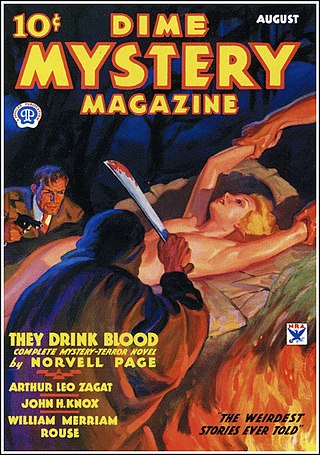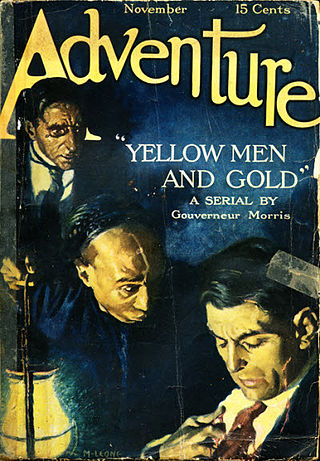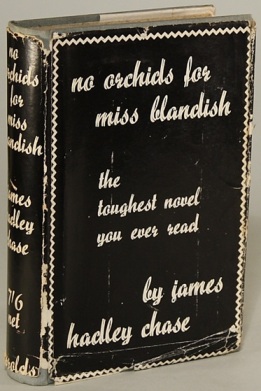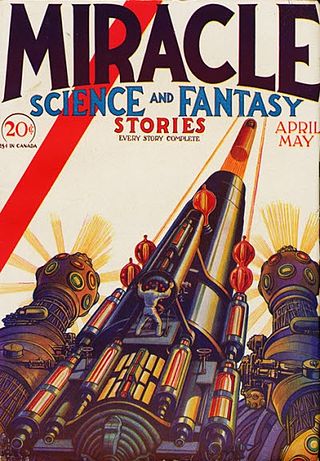Related Research Articles
Pulp magazines were inexpensive fiction magazines that were published from 1896 until around 1955. The term "pulp" derives from the cheap wood pulp paper on which the magazines were printed. In contrast, magazines printed on higher-quality paper were called "glossies" or "slicks". The typical pulp magazine had 128 pages; it was 7 inches (18 cm) wide by 10 inches (25 cm) high, and 0.5 inches (1.3 cm) thick, with ragged, untrimmed edges. Pulps were the successors to the penny dreadfuls, dime novels, and short-fiction magazines of the 19th century.
James Michael Coonan is an American mobster and racketeer from Manhattan, New York who served as the boss of the Westies gang, an Irish mob group based in Hell's Kitchen, from approximately 1977 to 1988. Coonan was incarcerated and began serving a 75-year prison term in 1988.
Popular Publications was one of the largest publishers of pulp magazines during its existence, at one point publishing 42 different titles per month. Company titles included detective, adventure, romance, and Western fiction. They were also known for the several 'weird menace' titles. They also published several pulp hero or character pulps.

A. A. Wyn was an American publisher.
T. J. English is an American author and journalist known primarily for his non-fiction books about organized crime — both contemporary and historical — criminal justice, jazz, and the American underworld.

Jewish-American organized crime initially emerged within the American Jewish community during the late 19th and early 20th centuries. In media and popular culture, it has variously been referred to as the Jewish Mob, the Jewish Mafia, the Kosher Mob, the Kosher Mafia, the Yiddish Connection, and Kosher Nostra or Undzer Shtik. The last two of these terms are direct references to the Italian cosa nostra; the former is a play on the word for kosher, referring to Jewish dietary laws, while the latter is a calque of the Italian phrase 'cosa nostra' into Yiddish, which was at the time the predominant language of the Jewish diaspora in the United States.

William Murray is an American novelist, journalist, short story, and comic book writer. Much of his fiction has been published under pseudonyms. With artist Steve Ditko, he co-created the superhero Squirrel Girl.

Weird menace is a subgenre of horror fiction and detective fiction that was popular in the pulp magazines of the 1930s and early 1940s. The weird menace pulps, also known as shudder pulps, generally featured stories in which the hero was pitted against sadistic villains, with graphic scenes of torture and brutality.

Adventure was an American pulp magazine that was first published in November 1910 by the Ridgway company, a subsidiary of the Butterick Publishing Company. Adventure went on to become one of the most profitable and critically acclaimed of all the American pulp magazines. The magazine had 881 issues. Its first editor was Trumbull White. He was succeeded in 1912 by Arthur Sullivant Hoffman (1876–1966), who edited the magazine until 1927.

Harold Brainerd Hersey was an American pulp editor and publisher, publishing several volumes of poetry. His pulp industry observations were published in hardback as Pulpwood Editor (1937).
Anatole France Feldman (1901–1972) is primarily known as a pulp magazine writer from the late-1920s to the late-1930s. He specialized in gangland fiction, appearing primarily in Harold Hersey's gang pulps, Gangster Stories, Racketeer Stories, and Gangland Stories. He also appeared in the rival magazines, Gun Molls and The Underworld.
Margie Harris was a pulp writer from 1930 to 1939. She was one of the most popular authors in the short-lived gang pulp genre. Even in an era of hardboiled crime fiction, her stories were unusually hard-edged and bitter. Her best work includes ingenious plotting, remorselessly violent characters, and colorful underworld argot. Most of her early stories appeared in the Harold Hersey-published pulp magazines Gangster Stories, Mobs, Prison Stories, Racketeer Stories, and Gangland Stories. When Hersey sold off his assets, Harris continued to appear in the successor to Gangster Stories, Greater Gangster Stories.

The New York Society for the Suppression of Vice was an institution dedicated to supervising the morality of the public, founded in 1873. Its specific mission was to monitor compliance with state laws and work with the courts and district attorneys in bringing offenders to justice. It and its members also pushed for additional laws against perceived immoral conduct. While the NYSSV is better remembered for its opposition to literary works, it also closely monitored the newsstands, commonly found on city sidewalks and in transportation terminals, which sold the popular newspapers and periodicals of the day.

No Orchids for Miss Blandish is a 1939 crime novel by the British writer James Hadley Chase. It was a critical and commercial success upon release, though it also provoked considerable controversy due to its explicit depiction of sexuality and violence. In 1942, the novel was adapted into a stage play and in 1948 it became a British film. The novel became particularly popular with British servicemen during World War II.

The Thrill Book was a U.S. pulp magazine published by Street & Smith in 1919. It was intended to carry "different" stories: this meant stories that were unusual or unclassifiable, which in practice often meant the stories were fantasy or science fiction. The first eight issues, edited by Harold Hersey, were a mixture of adventure and weird stories. Contributors included Greye La Spina, Charles Fulton Oursler, J. H. Coryell, and Seabury Quinn. Hersey was replaced by Ronald Oliphant with the July 1 issue, probably because Street & Smith were unhappy with his performance.

Miracle Science and Fantasy Stories was an American pulp science fiction magazine which published two issues in 1931. The fiction was unremarkable, but the cover art and illustrations, by Elliott Dold, were high quality, and have made the magazine a collector's item. The magazine ceased publication when Dold became ill and was unable to continue his duties both as editor and artist.

Ghost Stories was an American pulp magazine that published 64 issues between 1926 and 1932. It was one of the earliest competitors to Weird Tales, the first magazine to specialize in the fantasy and occult fiction genre. It was a companion magazine to True Story and True Detective Stories, and focused almost entirely on stories about ghosts, many of which were written by staff writers but presented under pseudonyms as true confessions. These were often accompanied by faked photographs to make the stories appear more believable. Ghost Stories also had original and reprinted contributions, including works by Robert E. Howard, Carl Jacobi, and Frank Belknap Long. Among the reprints were Agatha Christie's "The Last Seance", several stories by H.G. Wells, and Charles Dickens's "The Signal-Man". Initially successful, the magazine began to lose readers and in 1930 was sold to Harold Hersey. Hersey was unable to reverse the magazine's decline, and publication of Ghost Stories ceased in early 1932.

Flash Gordon Strange Adventure Magazine was a pulp magazine which was launched in December 1936. It was published by Harold Hersey, and was an attempt to cash in on the growing comics boom, and the popularity of the Flash Gordon comic strip in particular. The magazine contained a novel about Flash Gordon and three unrelated stories; there were also eight full-page color illustrations. The quality of both the artwork and the fiction was low, and the magazine saw only a single issue. It is now extremely rare.

New Mystery Adventures was a pulp magazine that appeared from 1935 to 1937. It included a mix of genres: there were occasional science fiction stories, and fantasies such as "Buried Alive" by Wayne Rogers and "Rescued by Satan" by Richard B. Sale, as well as adventure stories by authors such as L. Ron Hubbard. There were also mystery stories and weird menace stories. One story in Lars Anderson's "Domino Lady" series appeared, and other mystery writers included Octavus Roy Cohen and Steve Fisher.

Dime Mystery Magazine was an American pulp magazine published from 1932 to 1950 by Popular Publications. Titled Dime Mystery Book Magazine during its first nine months, it contained ordinary mystery stories, including a full-length novel in each issue, but it was competing with Detective Novels Magazine and Detective Classics, two established magazines from a rival publisher, and failed to sell well. With the October 1933 issue the editorial policy changed, and it began publishing horror stories. Under the new policy, each story's protagonist had to struggle against something that appeared to be supernatural, but would eventually be revealed to have an everyday explanation. The new genre became known as "weird menace" fiction; the publisher, Harry Steeger, was inspired to create the new policy by the gory dramatizations he had seen at the Grand Guignol theater in Paris. Stories based on supernatural events were rare in Dime Mystery, but did occasionally appear.
References
- ↑ "Gang Pulp". Off Trail Publications. Retrieved 21 February 2016.
- ↑ Galactic Central
- ↑ Hersey, Harold. Pulpwood Editor. Frederick A. Stokes, 1937.
- ↑ Locke, John; editor. Gang Pulp. Off-Trail Publications, 2008. ISBN 978-1-935031-00-0.
- ↑ Feldman, Anatole & Will Murray (introductions). The Gangland Sagas of Big Nose Serrano: Volumes 1-3. Off-Trail Publications, 2008-09. ISBN 978-1-935031-01-7, ISBN 978-1-935031-04-8, ISBN 978-1-935031-07-9.
- ↑ Credicott, Richard. Crime Stories by Richard Credicott, Off-Trail Publications, 2011. ISBN 978-1935031178.